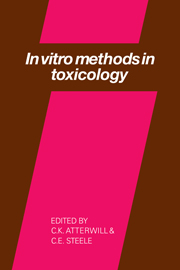Book contents
- Frontmatter
- Contents
- List of contributors
- Preface
- Introduction
- TARGET ORGAN TOXICITY
- In vitro methods in renal toxicology
- Ototoxicity
- Cultured cell models for studying problems in cardiac toxicology
- Use of the isolated rat heart for the detection of cardiotoxic agents
- Brain reaggregate cultures in neurotoxicological investigations
- Application of thryoid cell culture to the study of thyrotoxicity
- In vitro methods to investigate toxic lung disease
- Metabolism and toxicity of drugs in mammalian hepatocyte culture
- In vitro evaluation of haemic systems in toxicology
- GENERAL AND TOPICAL TOXICITY
- REPRODUCTIVE TOXICITY
- CONCLUSION
- Index
Application of thryoid cell culture to the study of thyrotoxicity
Published online by Cambridge University Press: 06 August 2010
- Frontmatter
- Contents
- List of contributors
- Preface
- Introduction
- TARGET ORGAN TOXICITY
- In vitro methods in renal toxicology
- Ototoxicity
- Cultured cell models for studying problems in cardiac toxicology
- Use of the isolated rat heart for the detection of cardiotoxic agents
- Brain reaggregate cultures in neurotoxicological investigations
- Application of thryoid cell culture to the study of thyrotoxicity
- In vitro methods to investigate toxic lung disease
- Metabolism and toxicity of drugs in mammalian hepatocyte culture
- In vitro evaluation of haemic systems in toxicology
- GENERAL AND TOPICAL TOXICITY
- REPRODUCTIVE TOXICITY
- CONCLUSION
- Index
Summary
INTRODUCTION
Ihe technique of thyroid cell culture provides a novel approach to the study of potential adverse effects of compounds or drugs on the thyroid gland. An assessment of drug-induced thyrotoxicity in vitro can be achieved economically in terms of time, quantities of test compound and numbers of animals. Furthermore, good tissue culture models permit human thyroid cell culture studies to be performed.
Identification of thyrotoxicity in vivo is usually achieved by observations of histopathological changes in the thyroid glands. These changes may arise either by a direct action on the thyroid gland or indirectly by altering hypothalamic thyrotrophin releasing hormone (1RH) and pituitary thyroid stimulating hormone (TSH) secretion, or target tissue and hepatic thyroid hormone metabolism. An advantage of in vitro studies is that they allow the thyroid cells to be examined in isolation from the inevitably complex and undefined interactions with their environment in vivo.
Over the past fifteen years numerous thyroid in vitro systems have been developed including primary and continuous thyroid cell culture, tissue slices and cell suspension culture. This chapter will focus on the practical aspects of primary and continuous cell culture. For details of the other thyroid in vitro methods the reader is referred to the following papers: Nitsch, et al. (1984); Heldin, et al. (1985); Schuman, et al. (1976).
Integration of thyroid cells into a follicular epithelium is an essential prerequesite of normal thyroid function since, as a consequence of this integration, thyroid cells gain polarity, and directional transport of material takes place.
- Type
- Chapter
- Information
- In Vitro Methods in Toxicology , pp. 165 - 188Publisher: Cambridge University PressPrint publication year: 1987
- 1
- Cited by



